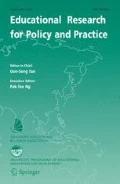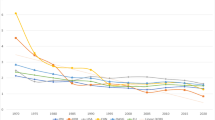Abstract
Educational inequality is a highly debated yet empirically understudied topic in Malaysia. This paper examines the patterns and trends of academic achievement gaps by student social groups in Malaysia, drawing upon nationally representative data for the most recent four cohorts (1999, 2003, 2007, and 2011) of eighth-grade Malaysian students from the Trends in International Mathematics and Science Study. Results show that while the achievement gaps by gender (female vs. male) and ethnicity (Malay vs. non-Malay) existed at various time points and have changed over time, the magnitudes of change were small. Most alarmingly, the achievement gaps both in math and in science between students from high and low socioeconomic families have rapidly widened and became more prominent than gender and ethnicity gaps in recent years. If this trend continues, it will have dire consequences for economic equality and social stability in the society. To reduce educational achievement gaps, policymakers and educators should play a more active role in supporting academically disadvantaged students, especially those who are from underprivileged backgrounds.


Similar content being viewed by others
Notes
Some other dimensions for identifying achievement gaps are geographical (e.g., urbanicity, regions) or political (e.g., immigration status).
These studies generally concluded that in terms of educational attainment in secondary and post-secondary schools, a Malay advantage trend emerged when comparing birth cohorts across multiple decades pre- and post-independence of Malaysia (Lillard and Willis 1994; Pong 1993, 1995). Furthermore, Pong (1993) found that within Malay group the gender and socioeconomic gaps in educational attainment closed but within non-Malay group they persisted and even widened in some cases.
Two additional proxies of family socioeconomic status, number of books at home and home possessions, were used for the same analysis in this paper. The findings yield similar patterns to the results using parental education as a proxy of socioeconomic status reported in this paper.
According to the report Population Distribution and Basic Demographic Characteristics 2010 (Census 2010) released by the Malaysian Department of Statistics (2014), Malay group accounts for about 58 % of teenagers aged 10–14 in the country. The calculations of Malay students in our sample based on the measure of “frequency of use of language of test at home” yield slightly higher percentages at the similar age, but the numbers are quite close to those reported in the Census 2010. It gives us more confidence that our ethnicity identification strategy is reasonable.
References
Bedard, K., & Ferrall, C. (2003). Wage and test score dispersion: Some international evidence. Economics of Education Review, 22(1), 31–43.
Blau, F., & Kahn, L. (2005). Do cognitive test scores explain higher US wage inequality? Review of Economics and Statistics, 87(1), 184–193.
Breen, R., & Luijkx, R. (2007). Social mobility and education: A comparative analysis of period and cohort trends in Britain and Germany. In S. Scherer, R. Pollak, G. Otte, & M. Gangl (Eds.), From origin to destination: Trends and mechanisms in social stratification research (pp. 102–124). New York: Campus.
Brown, G. K. (2007). Making ethnic citizens: The politics and practice of education in Malaysia. International Journal of Development, 27(3), 318–330.
Chmielewski, A. K. (2014, aPRIL). Changes in socioeconomic achievement gaps in international comparison, 1964–2012. Paper presented at the 2014 American Educational Research Association annual meeting, Philadelphia, PA.
Clark, J. L. (Ed.). (2014). Closing the achievement gap from an international perspective. Dordrecht: Springer.
Coleman, J. S. (1968). The concept of equality of educational opportunity. Harvard Educational Review, 38(1), 7–23.
Coleman, J. S., Campbell, E. Q., Hobson, C. J., McPartland, F., Mood, A. M., Weinfeld, G. D., et al. (1966). Equality of educational opportunity. Washington, DC: U.S. Government Printing Office.
Cutler, D. M., & Lleras-Muney, A. (2010). Understanding health differences by education. Journal of Health Economics, 29(1), 1–28.
Ferreira, F. G., & Gignoux, J. (2014). The measurement of educational inequality: Achievement and opportunity. World Bank Economic Review, 28(2), 210–246.
Fryer, R. G., & Levitt, D. (2004). Understanding the Black–White test score gap in the first two years of school. Review of Economics and Statistics, 86(2), 447–464.
Gamoran, A., & Long, D. A. (2007). Equality of educational opportunity: A 40-year retrospective. In R. Teese, S. Lamb, & M. Duru-Bellat (Eds.), International studies in educational inequality: Theory and policy (pp. 23–47). New York: Springer.
Goldin, C., & Katz, L. (2010). The race between education and technology. Cambridge, MA: Harvard University Press.
Hillygus, D. S. (2005). The missing link: Exploring the relationship between higher education and political behavior. Political Behavior, 27(1), 25–47.
Hout, M. (1988). More universalism, less structural mobility: The American occupational structure in the 1980s. American Journal of Sociology, 93(6), 1358–1400.
Ismail, N. A. (2009). Understanding the gap in mathematics achievement of Malaysian students. The Journal of Educational Research, 102(5), 389–394.
Ismail, N. A., & Awang, H. (2007). Differentials in mathematics achievement among eighth-grade students in Malaysia. International Journal of Science and Mathematics Education, 6(3), 559–571.
Ismail, N. A., & Awang, H. (2009). Mathematics achievement among Malaysian students: What they can learn from Singapore. International Education Studies, 2(1), 8–17.
Ismail, N. A., & Awang, H. (2012). Student factors and mathematics achievement: Evidence from TIMSS 2007. Eurasia Journal of Mathematics, Science & Technology Education, 8(3), 249–255.
Kenayathulla, H. B. (2013). Household expenditures on private tutoring emerging evidence from Malaysia. Asia Pacific Education Review, 14(4), 629–644.
Klitgaard, R., & Katz, R. (1983). Overcoming ethnic inequalities: Lessons from Malaysia. Journal of Policy Analysis and Management, 2(3), 333–349.
Lillard, L. A., & Willis, R. J. (1994). Intergenerational educational mobility: Effects of family and state in Malaysia. Journal of Human Resources, 29(4), 1126–1166.
Mackenbach, J., & Bakker, M. (Eds.). (2002). Reducing inequalities in health: A European perspective. London: Routledge.
Madeira, R. A., & Rangel, M. A. (2014). Racial achievement gaps in another America: Discussing schooling outcomes and affirmative action in Brazil. In J. V. Clark (Ed.), Closing the achievement gap from an international perspective (pp. 127–160). Dordrecht: Springer.
Magnuson, K., & Waldfogel, J. (Eds.). (2008). Steady gains and stalled progress: Inequality and the Black–White test score Gap. New York: Russell Sage Foundation.
Mann, H. (1848). Horace Mann on education and national welfare. Twelfth Annual Report of Horace Mann as Secretary of Massachusetts State Board of Education. Retrieved from http://www.tncrimlaw.com/civil_bible/horace_mann.htm.
Martin, M. O., Mullis, I. V. S., Foy, P., & Stanco, G. M. (2012). TIMSS 2011 international results in science. Chestnut Hill, MA: Boston College.
Mohammadpour, E. (2012). A multilevel study on trends in Malaysian secondary school students’ science achievement and associated school and student predictors. Science Education, 96(6), 1013–1046.
Mullis, I. V. S., Martin, M. O., Foy, P., & Arora, A. (2012). TIMSS 2011 international results in mathematics. Chestnut Hill, MA: Boston College.
Ng, K. T., Lay, Y. F., Areepattamannil, S., Treagust, D. F., & Chandrasegaran, A. L. (2012). Relationship between affect and achievement in science and mathematics in Malaysia and Singapore. Research in Science & Technological Education, 30(3), 225–237.
Nie, N., Junn, J., & Stehlik-Barry, K. (1996). Education and democratic citizenship in America. Chicago, IL: University of Chicago Press.
Pong, S. L. (1993). Preferential policies and secondary school attainment in peninsular Malaysia. Sociology of Education, 66(4), 245–261.
Pong, S. L. (1995). Access to education in Peninsular Malaysia: Ethnicity, social class, and gender. Compare, 25(3), 239–252.
Reardon, S. F. (2011). The widening academic achievement gap between the rich and the poor: New evidence and possible explanations. In R. Murnane & G. Duncan (Eds.), Whither opportunity? Rising inequality and the uncertain life chances of low-income children (pp. 91–115). New York: Russell Sage Foundation Press.
Saw, G. K. (2015). Family and school factors relating to academic achievement gaps in Malaysia. In S. H. Ngu (Ed.), Essays in 2014 Malaysia Chinese Education Conference: Challenges and Reforms (pp. 241–263). Malaysia: Merdeka University Berhad, LLG Cultural Development Centre, Centre for Malaysian Chinese Studies.
Singh, J. S., & Mukherjee, H. (1993). Education and national integration in Malaysia: Stocktaking after thirty years of independence. International Journal of Educational Development, 13(2), 89–102.
Stoet, G., & Geary, D. C. (2013). Sex differences in mathematics and reading achievement are inversely related: Within- and across-nation assessment of 10 years of PISA data. PLoS ONE, 8(3), e57988.
Toh, K. W. (1984). Education as a vehicle for reducing economic inequality. In S. H. Ali (Ed.), Ethnicity, class and development: Malaysia (pp. 224–264). Kuala Lumpur: Persatuan Sains Sosial Malaysia.
Walker, M. (2011). PISA 2009 Plus results : Performance of 15-year-olds in reading, mathematics and science for 10 additional participants. Melbourne: ACER Press.
Author information
Authors and Affiliations
Corresponding author
Rights and permissions
About this article
Cite this article
Saw, G.K. Patterns and trends in achievement gaps in Malaysian Secondary Schools (1999–2011): gender, ethnicity, and socioeconomic status. Educ Res Policy Prac 15, 41–54 (2016). https://doi.org/10.1007/s10671-015-9175-2
Received:
Accepted:
Published:
Issue Date:
DOI: https://doi.org/10.1007/s10671-015-9175-2




